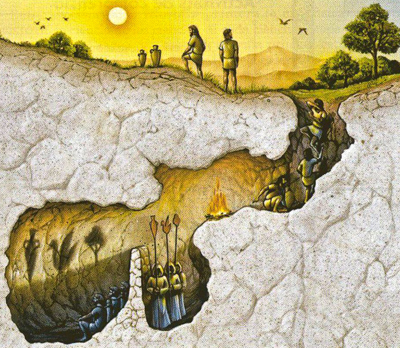Revelation and Worship of the Really Real - Week 6
Many years ago as a young college student, I went on a religious study tour of the countries of Egypt and Israel. One certain day stands out as a highlight, and in particular, one item of food.
The group had spent the day walking around an Egyptian neighborhood. Though the weather was hot, and social awkwardness left me feeling out of sorts with the group, we enjoyed speaking to local vendors, to children and to a holy man at a temple who served sweet tea and spoke to us of his faith. At the end of the day, when I was spent and sweltering, someone gave me an orange.
To this day, I have not forgotten this orange. In contrast to my dusty surroundings, its juicy, citrus sweetness was refreshing and while I know the orange was not a deity, my response felt akin to worship. I could not contain myself. It erased all barriers and transcended any temporal discomfort. This orange seemed more real than any orange I’d ever had, making me think what I’d eaten before was only a pale imitation. This is what oranges were intended to be; an “orange within the orange," or as a child might put it, “really real”.
Years later I tried to capture my experience in a poem but like any mystical experience, words didn’t do it justice. As I write this paragraph, I sigh and realize they still don’t.
Seeing the World Differently
This experience came to mind when considering the topic of worship in Revelation. John’s descriptions of the seven visions he received are over the top and you get the sense he can’t quite find the words either. As the Christians in Ephesus listened to Revelation read aloud in the worship service, they got a sense of another dimension of reality. Their eyes were opened to see the world differently.
Normally in their day to day world, everyone was urged and in fact commanded to worship the Emperor in vast ceremonies. Both imperial and local cult celebrations in John’s day pulled out all the stops when it came to worshipping the rulers of the day, but the scenes in Revelation made them seem puny in comparison. The adoration the Lamb receives utterly surpasses anything the Empire came up with, making their ceremonies appear gaudy and a cheap replica of the real thing. Worship of the Emperor had its rituals, but seeing the slaughtered-but-living Lamb was the real thing, a taste of the holy. And like my taste of the orange, it left them forever changed. Everything was different now.
Perhaps after hearing them, the world looked just a bit more touched by God, and their small worship services became more imbued with the state of awe inherent in John’s visions. Revelation gave them, and gives us even now, eyes to see the whole world with a kind of sacramental vision.
World Within World
In C.S. Lewis’ Chronicles of Narnia series, a similar world is discovered at the end of their journey in The Last Battle. When the children reach the “New Narnia," they don’t escape their homeland but instead go more deeply into God’s picture. The new place is the same as the world they left behind, but everything is more radiant. It is “more like the real thing.” New Narnia is “world within world,” Lucy realizes. The poet Gerard Manley Hopkins sees this same radiance when he declares, “The world is charged with the grandeur of God.” This world beckons us like it did for the children of Narnia, “Come further up, come further in!”
In the seven scenes of worship in Revelation, we are invited to see God’s presence everywhere in the world around us. Like the children in the New Narnia, the early Christians would have seen their same old world now charged with God’s grandeur, as the poet said so eloquently. Their perception is fundamentally altered. For people whose literal world was filled with temptations to conform and oppression if they didn’t, they needed to see this world.
Ultimate Concern
Almost 2000 years later, we too need to see this new world, for much of the time, we are distracted by the false gods of our age and fooled about what has greatest value. In John’s day, the Emperor was promoted as the real deal; worthy of all praise. Rome had a seductive propaganda and Christians were manipulated and wooed into the worship of the empire.
Long ago, Plato wrote about someone getting duped into thinking they knew what was real. In his famous story, prisoners are sitting in a cave, where they’re chained and forced to face a wall. Behind them is a fire, and all day long, a parade of human life walks across a bridge, casting shadows on the wall in front of the prisoners. Because they’ve been chained there all their lives, they think the shadows are the real thing. But shadows are not the same as the “really real”.
Plato was teaching his students that we are actually freed from our chains in the cave and freed to understand that the shadows are not real. We can apprehend what is real because there are no chains around our wrists and ankles.
Or are there? Even though we are free, much of the time we act like these prisoners. So much parades as a priority, begging our loyalty — money, looks, personal success, relationships, fun, travel, sports, security… The list is endless and some priorities, like justice, stewardship of the earth, or artistic expression, would even be considered spiritual.
Though none of these are wrong in themselves, the worship scenes in Revelation inspire us to embrace what theologian Paul Tillich once described as our “ultimate concern.” We are grasped by it because it has moved us deeply and seems sacred, numinous or holy. People put their faith in it. What we really believe and value will shape they way we live, but we must be careful, for ultimate concerns have the capacity to heal as well as destroy a person.
The ultimate concern for the worshipping throngs in Revelation was the central hero, that slaughtered-but-living lamb who was actually a warrior king, the One who can and already has conquered every imperial pretender. This lamb, Jesus, not the powers that be, was worthy of worship.
In making Jesus their ultimate concern, the Christians would not worship the emperor and this was considered treason. Worship of the emperor could take place beside the local or national gods in John’s day, but certainly not to the exclusion of the emperor. This kind of worship was subversive and explained why the Christian community in Revelation experienced oppression and even persecution. The worship in Revelation inherently condemned empire and all those who supported the empire’s evil program.
“Holy, Holy, Holy, Lord God Almighty!” (Revelation 4:2-11)
Of all the seven visions, what John sees in the throne room is said to be central to the entire book. Everything is anchored in this scene. “In heaven stood a throne.”
Thrones are big in Revelation, mentioned time and again. To us a throne seems archaic, but in the ancient world it represented sovereignty and lordship. Whoever sat on it commanded ultimate concern. In this heavenly room, the majestic throne is at the center, surrounded by concentric circles. It wasn’t just that God’s crown had gems, but his whole presence had a radiant, gem-like splendor. The sea of glass (reminding us of a still, calm lake) comes from the molten glass that flows between the cherubim. It’s a stilled sea, because God has calmed the chaos. That’s why the 24 elders lay down their crowns, because God is in control of the chaos of the world.
As we learned in the previous blogpost, the One at the center of this whole scene is not out to protect his own power. He is a sacrificer and his authority is not patriarchal or top-down, but relationship centered. This Ruler will do anything for the good of his subjects, even give his own life.
The Emperor could never have matched this scene. This heavenly Ruler is so much more transcendent than we can ever imagine. Every sentient being in the universe is surrounding God. This is reality. They all owe their love, their devotion, their worship, their very existence, to God. “Thou are worthy, to receive glory and honor and power," they sang. As he’s writing it all down, John is probably thinking of Nero, or other Emperors, sitting in their Empire, and he asks, “Who is more powerful?” It’s not Nero or Claudius. It’s the One who all sentient beings rest upon.
What, or rather who, was under the throne is just as important. Those who are suffering, and those who have died because of their faith, are sitting underneath the throne of God, crying out, “How long? How long?” That is, how long do we still have to suffer? The scroll, sealed with seven seals, hasn’t been opened yet and God reveals that He’s waiting so that grace can be manifest to as many as possible.
We don’t usually get big visions like this, or experience worship on such a grand scale. Much of the time, our experience can be dry or dull, or we get small hints and “see through a mirror dimly” as 1 Corinthians 13:12 says.
But when we read John’s descriptions, we begin to see our world differently. Each scene describes an encounter with what, or rather Who, is Real. We are called to renew our faith in the One who is truly in charge of the cosmos and all history. In this encounter with what is really real, we wonder why we ever settle for less when we gather to give God praise and thanksgiving.
Knowing that there is another dimension of reality from which our world originates, way deeper than surface appearances, helps our imagination. We can appreciate what we have and look forward to what will eventually be. The Psalmist writes of stars that sing, animals that praise, and trees that clap their hands in praise of God. As surrealistic as it sounds, this is the world we might have come from. This is the world we get echoes of when we are in a worshipful attitude. Just like my taste of the “orange within the orange," there is also a “world within the world," God’s world, which is the “really real” one, despite appearances to the contrary.
Every so often, when our hearts get caught in song, when someone’s compassion evokes our tenderness or when our anxious minds get stilled by a calm lake, we might see that the poet was right. The world really is charged with the grandeur of God when our eyes are opened as John’s were in the visions. As we imagine the Reality of this world with John, as we trust in this God, maybe we will go more deeply into God’s picture, like the Narnia children.
Lord knows we need this kind of worship, weighty and dense with meaning, redirecting our wayward hearts back to True North.
Questions for Engagement — Week 6
- Have you ever had an experience of the really real that left you in a state of awe?
- How is the worship portrayed in Revelation similar to or different from experiences of worship in churches today?
- Ancient Celts and later Christians had a term to describe times and places that are “really real”: thin places. Thin places happen when the distance between heaven and earth collapses and we are able to catch glimpses of the divine. Describe a thin place you have experienced.
- Think about experiences you’ve had of powerful worship. What made it work for you? What lasting impression has that experience had on you?
In case you’d like to read more…
- Craig Koester, The Apocalypse: Controversies and Meaning in Western History, Lecture 6 — “God, The Lamb, and the 7 Seals”
- Read or listen to the vision that inspired worship in Revelation 4:2-11
- Click here to read Gerard Manley Hopkins’ poem “God’s Grandeur”
- Unveiling Empire: Reading Revelation Then and Now by Wes Howard-Brook and Anthony Gwyther (chapter 7)
- The allegory of Plato’s Cave is told in a 3 minute clay animation
Next Post





